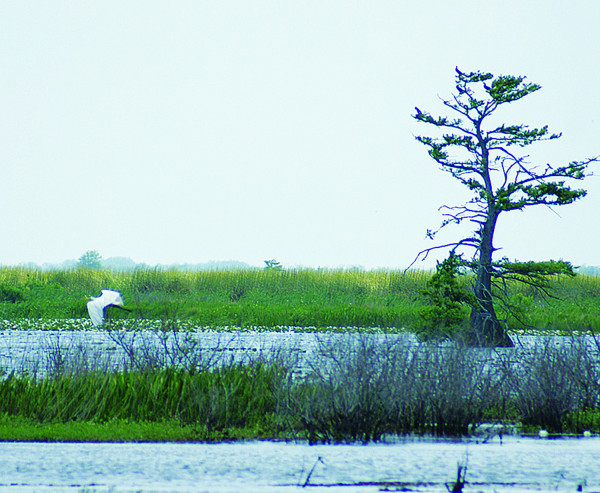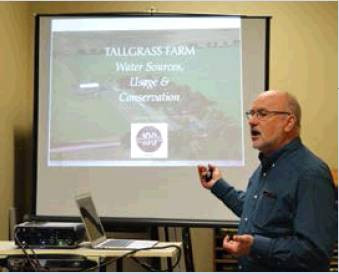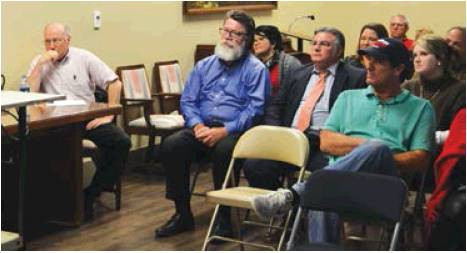Liquid Abundance


Daily News photo by Allison Cryer
Rice farming expert Burt Tietje talked about how critical water is to the agriculture industry in Southwest Louisiana.

Roanoke farmer Burt Tietje was the guest speaker Thursday for the first in a series of programs that are part of the Smithsonian Museum’s Water/Ways exhibit at Zigler Art Museum.
Tietje lives on his family’s 440-acre property, Tall Grass Farm, which is located between Jennings and Roanoke, bordering the east side of the Grand Marais drainage system.
“Water is important to the economy here as well as in the U.S.,” he said. “Natural resources are the only real way of adding wealth into the economy. All wealth goes back to natural resources, everything else is just services.”
He said Jeff Davis Parish is known for rice production, an industry which thrives primarily due to adequate water sources.
“On average, Jeff Davis produces around 80,000 acres of rice each year, which results in around $53.5 million coming into our economy annually,” he said. “Rice is a significant industry for us here.”
While rice is Southwest Louisiana’s primary product, Tietje said crawfish farming in rice fields has steadily increased since it was first introduced in 1995. According to the LSU AgCenter, in the year 2000, crawfish comprised around two percent of rice farmer’s income. However, today that number has skyrocketed to around 45 percent.
“Now we grow crawfish on 50,000 acres each year, which brings in around $46.4 million each year,” he said. “Crawfish helps provide farmers with income between around January to June of each year. Crawfish is keeping us in business.”
Unlike petroleum, Tietje said agricultural products are a renewable resource and create downstream economic activity.
“Crawfish is a great economic multiplier,” he said. “Also, with $135 million coming into our state each year in revenues from the entire agricultural industry, I am an unapologetic fan of agriculture and what it does for our parish.”
He said without adequate water sources, the ag industry would come to a halt.
“Farms need water. Even cattle farmers are grass farmers first, so water is important to everyone,” he said.
Farmers can source water needed for their crops in many ways, however, Tietje said the most dependable, efficient way is through water wells that access an aquifer deep below the surface.
“Before wells, aquifers and other sources were used we just depended on Mother Nature and luck,” he said. “That is why it was called provenance rice.”
Tietje said with the assistance of a costsharing program with the U.S. Department of Agriculture’s Natural Resources Conservation Service, (NRCS) he was able to install a 250-foot deep electric motor well that he said cost around half of what it took to operate his old diesel-engine operated well.
“NRCS looks at soil and water conservation by entering into cost-sharing programs that assist farmers with more efficient infrastructure,” he said.
He said farmers can also get assistance with purchasing equipment that conserves water such as a laser leveling machine that identifies low points and creates an absolutely flat surface that utilizes less water.
In Jeff Davis, farmers tap into the Chicot Aquifer system, basically an underground river that spans 9,000 square miles and is the sole source of drinking water for all of Southwest Louisiana.
“This is what makes our agriculture industry possible,” he said. “Around 85 percent of the water we draw from the Chicot system is used for agriculture.”
Tietje said threats to the earth’s aquifers could come from several ways, such as overuse by certain industries that could deplete the system. Also, contamination, saltwater intrusion and nationalization of water as as resource could eventually deplete the world’s water supply. All of this, he said, would be devastating to agriculture and the economy, as well as human life.
He said scientists predict that the next major world war will be over water as a natural resource.
“While many believe the next world war will be over oil with everything that is going on in the Middle East, I predict it will be over water,” Tietje said.
He said while China grows the most rice on Earth, the country still has to source soybean and other agricultural products because there isn’t enough green land to support the country’s growing consumption of meat.
“In China, the deserts are expanding by hundreds of acres a year, so they are having to import soybeans because they don’t have enough water to produce enough to feed to their livestock,” he said.
In Louisiana, Jeff Davis and Acadia parishes together produce around 80 million crawfish annually and are by far the biggest producers of crawfish in the U.S. However, the number of farmers in the parish is dwindling.
“Currently the average age of rice farmers here is 58 years old,” he said. “We only have 120 farmers producing all the rice in Jeff Davis.”
Zigler Director Celia Jo Black said ultimately Water/Ways serves a higher purpose than art and culture.
“That is why this exhibit and the discussion around water as a resource is important,” she said. “We need to get future generations to care about water conservation and farming in Jeff Davis.”
“Farms need water. Even cattle farmers are grass farmers first, so water is important to everyone.”
– Burt Tietje
